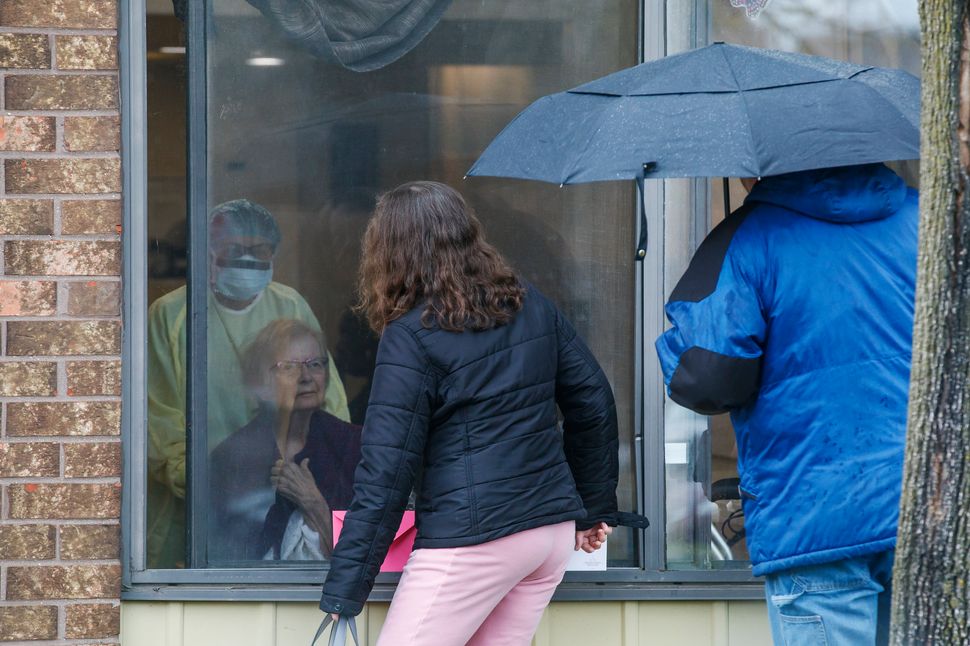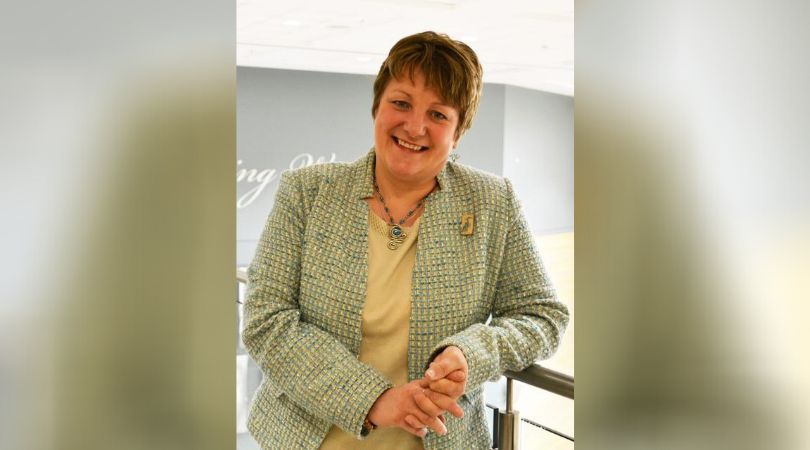
Once a week, Sandie Berenger visits her 90-year-old father Norman at his Stoney Creek, Ont., long-term care home.
During their outdoor visits — after she’s been asked about her health and had her temperature taken — the pair sit at separate ends of a table, at least six feet apart, as a mandatory precaution during the COVID-19 pandemic. A staff member stays in the garden, supervising the visit.
Berenger has tried to explain the pandemic to her father, but he says he doesn’t understand why the visits are so short and why they can’t get a cup of tea or coffee or have a picnic like they have in the past.
The home has had fewer than five COVID-19 deaths, and hasn’t had any cases since May, Berenger said.
Before Ontario resumed family visits in June, Berenger would stand outside and visit as her father stood on a second-floor balcony of Heritage Green Nursing Home.

Norman, who has mild dementia, loves the outdoors and the sun. Stuck inside his room for five months and counting, he read the newspaper and looked out his window, watching firefighters and trucks outside at the nearby fire department.
In their daily phone calls, Berenger can hear in her father’s voice that he’s lonely and depressed. She’s trying to stay strong for him, but says it’s hard not to notice his memory loss and comprehension issues worsening. Lately, he’s been forgetting words. Berenger doesn’t want to think about what a second wave of the pandemic could mean for her father, or for herself.
“I can’t imagine, because I feel like this 30-minute outdoor visit is something to look forward to, for both of us, once a week,” she told HuffPost Canada.
She calls the short visits the “crumbs” that the government has given families.
A spokesperson for Ontario’s Ministry of Long-Term Care said the government recognizes the important role that families play in providing caregiving and emotional support.
“We have moved cautiously, to balance the reintroduction of visits with the need to keep residents and staff in long-term care homes safe, and to ensure risks are mitigated,” Tanya Blazina said.
As the pandemic evolves, the ministry’s direction on long-term care visits will be updated to ensure the safety and emotional wellbeing of residents and staff, she added.
Heritage Green has not responded to HuffPost’s request for comment.
“In my mind, it’s quite a fight to become an essential caregiver, with the home not supporting it,” Berenger said.
With the visits and phone calls, “I’m trying my best to keep him going, keep him cognitively aware and everything, so I can’t imagine [a second wave] … it could be devastating,” she said.
Berenger is not alone — many other family members are fighting to become essential caregivers right now, to provide not only help with physical tasks but desperately needed emotional support for their loved ones before a potential second wave causes long-term care to shut down visits again.
Moving forward, experts say allowing families to visit their loved ones more frequently — as long as they’re trained in proper use of personal protective equipment (PPE) and infection control and prevention measures — could have critical health outcomes for residents. A focus on family visits also needs to be paired with renewed and urgent efforts to hire and train more staff, especially to provide care to residents who don’t have families, experts say.
Ontario visitor guidelines need work: doctor
Residents have the right to receive visitors of their choice, as outlined in Ontario’s long-term care act. Under the province’s Residents’ Bill of Rights, those who are dying or critically ill also have the right to have family or friends present 24 hours a day.
If a home is in outbreak, visitors defined as “essential” by the province of Ontario are the only ones allowed in. Those include anyone who provides an essential service such as food delivery, phlebotomy (drawing blood) or other health-care services. An essential visitor could also be a person visiting a palliative resident.
As of June 18, if a home does not have an outbreak, they are permitted to allow socially distant outdoor visits, like what Berenger has been doing. As of July 22, up to two visitors can visit a resident indoors.
More than 1,800 residents have died from COVID-19 in long-term care. As of Thursday there are only three active cases in long-term care residents, and 34 active cases in long-term care staff, per the province’s data.
WATCH: Ontario launches commission into COVID-19 pandemic’s effects on long-term care homes. Story continues below.
Now is the right time to allow families to visit loved ones in long-term care homes, said Dr. Samir Sinha, the Director of Geriatrics at the Sinai Health System and University Health Network.
Although it had some promising signs, Ontario’s most recent guidance on visiting policies doesn’t go far enough to find a balance between the risks the virus poses and the benefits of family visits, Sinha said.
He recommends individual homes implement the suggestions he and co-authors gave in a recent report, including:
Distinguishing between family members who perform essential caregiving services and general visitors;
Balancing the risk of infection with the risk of isolation on residents’ health;
Having flexible policies that prioritize giving residents the access to visitors they need;
Ensuring governments, public health authorities and long-term care homes are transparent in their communications about visitor policies;
Collecting and monitoring data on COVID-19 cases to support removing visitor restrictions;
And instituting methods for feedback on visitor policies and having an appeals process to solve disagreements around the policies.
Sinha points to the example set by the Netherlands, where 26 long-term care homes allowed visitors in and reported significant improvements in the wellbeing of residents — and no new COVID-19 cases.
“There’s no reason why family caregivers cannot come into a home to visit their loved ones, but let’s treat them like staff,” Sinha said. “Let’s make sure they know what the infection prevention and control protocols are, let’s make sure they know how to properly don and don off, or use, their PPE.”
“They're all suffering in silence.”
- Dr. Samir Sinha
Currently in Ontario, it’s up to individual homes to decide who gets the designation of an essential visitor, based on the province’s criteria. Many are saying they can’t allow more people in the home for safety reasons or that they don’t have the staff or supplies to support more visitors, according to Sinha.
That puts residents and families in a tough spot, he said. Prior to the pandemic, some residents may have been receiving a much higher level of care than they are now — a family member may have sat with them through meals to ensure they ate, whereas now staff might be rushing to feed residents.
Sinha also noted some people who weren’t providing more essential care before the pandemic, upon seeing their loved one’s decline over the last few months, may now want to provide more care.
“They’re all suffering in silence,” he said. “The residents are losing weight. Their family members are watching their loved ones waste away or not get their nutritional needs met. And now the idea that we should be allowing [visitors in to help] but that is still not happening, is almost further traumatizing families and residents.”
Concerns of a second wave top of mind for families
As Donnafaye Milton watches her mother’s health decline she feels she’s not only losing a close confidant and the family wisdom she used to share — she’s losing her mom’s music. Her mom, now 94, used to teach piano, and, prior to the pandemic, played at the church and memorial services at her Revera Inc. long-term care home in London, Ont.

During the COVID-19 pandemic, her mom has lost 40 pounds, as well as some of her memory and focus. Now she can’t pull the keyboard out to play. Her mom also used to go out to the home’s garden several times a day to remove dead flowers from plants. Now, because she’s lost weight, she can’t wheel herself over the bump in the floor between the dining room and garden to get there.
Before the pandemic, the two used to play games, and Milton’s mom, who Milton describes as whip smart, would read 25 books a month. She used to interact closely with staff because most people on her unit couldn’t hold a conversation. Now, Milton said, staff are too busy to socialize with her mom.
“Everybody I know is more than willing to learn how to put on all the PPE ...”
- Donnafaye Milton
Milton is trying to become an essential caregiver. She wants to help bring joy into her mom’s life, by helping her with her hobbies and giving her the chance to socialize more often. The home hasn’t given her a reason for denying her request, she said.
“Everybody I know is more than willing to learn how to put on all the PPE, [take] all the precautions. We’re willing to learn it, to do it, whatever it takes, and [then] we can help out, just as people always did,” she said.
Larry Roberts, a spokesperson for Revera, said all of the company’s long-term care homes in Ontario follow the ministry’s policies to safely manage visitors.
“We appreciate the patience and understanding of our family members regarding the safe visitation restrictions and are doing our best to accommodate as many visitors as possible while balancing staffing and safety requirements,” he said in an email.
He also said Revera homes are required to follow ministry definitions when assessing whether someone fits the criteria of an essential caregiver. In situations where someone does not meet the criteria, staff “do their best to accommodate alternative measures” like offering increased visits. The company is exploring a program to expand the role of family members as essential caregivers, he added.
On their current visits, Milton has to yell through her mask six feet away and her mom can’t hear her.
“She makes up what she thinks I’m saying in these inside visits that’s nowhere near what I’m saying, even though I’m yelling,” Milton said.
The threat of a second wave limiting visits is a big worry too. While Milton doesn’t mind getting a warm coat and taking regular COVID-19 tests to do outdoor visits in the winter, she noted other family members might not be able to visit outside. She can call her mom, but fears even phone calls may not be an option for other families in the event of a second wave, if their loved one can’t use a phone.
“That’s partly why I keep going, before we get shut out again,” she said.
Long-term care shouldn’t rely on family caregivers: experts
Janice Keefe, director of the Nova Scotia Centre on Aging at Mount Saint Vincent University, believes every resident in long-term care should have one family member with a caregiver designation, who would be trained on how to use PPE.
“If you don’t have any outbreaks in your facility, in my mind, there should not be a reason why trained, designated family members could not come and provide that care,” she told HuffPost.
“In my mind, it’s all about balancing risk and risk of spread to the community with quality of life.”
- Janice Keefe
In the event of a major outbreak at the home, visitors may have to be restricted again unless the home and family had a prior agreement, Keefe said. But, unlike what has happened with the first wave, visitors shouldn’t be locked out for months on end — once the outbreak is over, there should be more of an emphasis on allowing families in as soon as it’s safe.
“In my mind, it’s all about balancing risk and risk of spread to the community with quality of life,” she said.
It is also important, though, that the long-term care system is not relying on family members or hiring private caregivers to provide care that should come from staff, Keefe added.
“I just wouldn’t want us to end up with a system that only people with money or only [residents] with family members are the ones that kind of lucked out in this scenario.”

It’s ultimately not a one-size-fits-all approach, she said.
“We need to address that family opportunity or role that they could play to be part of the team,” Keefe said. “But we also need to do other things around enhancing staff benefits, enhancing numbers of staff and different types of staff to provide better quality of care and quality of life in the facilities.”
Pat Armstrong, a sociology professor at York University and co-author of a recent report on the future of long-term care, also worries about residents with no family.
“How do we address their loneliness, how do we address them not being fed, or bathed or walked?” she asked.

Armstrong noted if one family member helped a loved one eat, they’d often be helping other residents at the table too and advocating for their needs. Training for family members coming into long-term care homes should account for their prior knowledge, if they’ve already spent time in a caregiving role, she said.
“Why do we need families to go in there and provide essential care? Well, one of the reasons is that [staff are] not providing essential care,” she said.
Armstrong said it’s critical to have a strategy to increase staff levels, and one that recognizes that staff need to provide a full range of care. “And that needs to include this kind of social and emotional support,” she said. “We can’t treat that as a frill.”
She points to Quebec, where in June Premier François Legault announced the province would seek to hire 10,000 people to work in long-term care. The province offered a three-month training program including hands-on experience at long-term care facilities.
In contrast, an Ontario report on staffing in long-term care homes, released at the end of July called the state of long-term care staffing a “crisis.” The report was written in response to recommendations made in the Wettlaufer inquiry, which investigated the events that led to former nurse Elizabeth Wettlaufer murdering eight seniors.
“I think the question’s open about whether we will see any real change or not ...”
- Pat Armstrong
The report recommends a minimum of four hours of direct care per patient, more than they currently receive.
Blazina, the ministry spokesperson, said the province has “taken significant action to increase flexibility and funding, including issuing emergency orders, introducing amended regulations, and announcing $243 million in emergency funding for staffing, supplies, and capacity.”
The government will also release a comprehensive staffing strategy by the end of the year, she said.
Long-term care homes need to examine and change their visitor policies in consultation with unions, Armstrong said, because of the potential risk to staff in allowing family members in who could unintentionally spread the virus.
Armstrong said she has concerns about the province’s commission into long-term care and the COVID-19 pandemic and, although she likes to remain optimistic, she worries about a lack of changes moving forward.
“I think the question’s open about whether we will see any real change or not and I think that we have to keep working to make sure there is real change there,” she said.